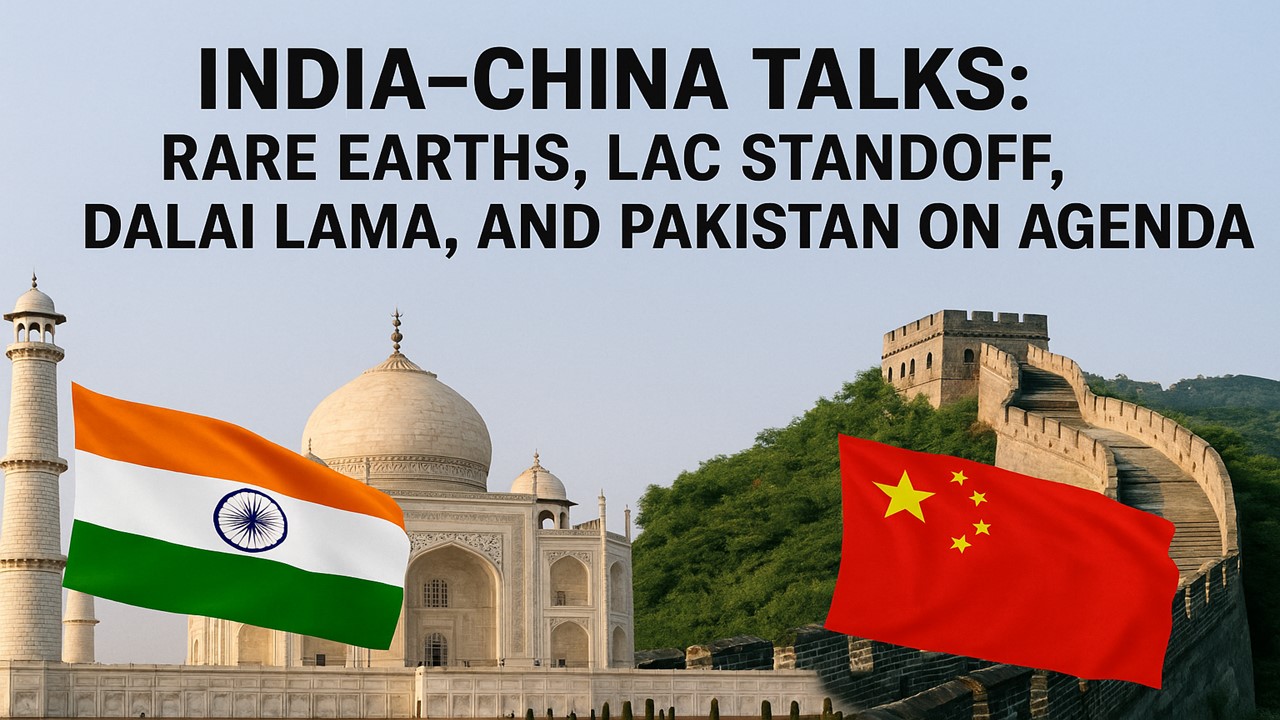
India-China Talks: Rare Earths, LAC Standoff, Dalai Lama, and Pakistan on Agenda
India–China Talks: Issues on the Table
External Affairs Minister S. Jaishankar is in Beijing for a high‑level visit—his first to mainland China since the 2020 Galwan Valley standoff. His talks with Chinese Foreign Minister Wang Yi are expected to focus on several sensitive and strategic issues.
1. Rare Earths Cooperation
- India is keen to secure access to rare‑earth minerals, which China dominates globally.
- Discussions are likely to include joint ventures or easing of export restrictions, as India tries to develop its own supply chains for critical minerals used in electronics, batteries, and defense.
2. LAC Border Situation
- The two sides have made little progress in fully resolving the Line of Actual Control (LAC) standoff in eastern Ladakh since 2020.
- India is expected to press China to fully disengage and restore the status quo ante.
- Talks may also touch on military confidence‑building measures.
☸️ 3. Dalai Lama Succession
- China has publicly stated that the issue of the Dalai Lama’s succession is a “thorn” in bilateral relations.
- Beijing insists it alone can approve the next Dalai Lama, while India allows the Tibetan spiritual leader to operate from Dharamshala.
- India is unlikely to change its position, but it remains a key irritant.
4. Pakistan Factor
- India is concerned over the growing China‑Pakistan nexus, including the China–Pakistan Economic Corridor (CPEC) through Pakistan‑occupied Kashmir.
- Jaishankar is expected to raise this issue as part of India’s objections to Chinese investments in contested territories.
Why These Talks Matter
✅ The discussions come as India prepares to host the SCO summit later this year, and as both sides face Western pressure to improve regional stability.
✅ India wants to balance its own economic and strategic interests without further alienating its largest neighbor.
✅ Rare earth cooperation and border stability are crucial for India’s semiconductor, defense, and infrastructure ambitions.
- A short analysis: implications for India.
- A timeline of India–China tensions since 2020.
- A FAQ on the Dalai Lama succession controversy.
Q1: Why is S. Jaishankar visiting China now?
A: This is his first visit since the 2020 Galwan Valley clash. The goal is to resume high-level diplomatic engagement, discuss unresolved border issues, and explore economic cooperation, particularly in rare earths.
Q2: What are rare earths, and why are they important?
A: Rare earth elements are a group of 17 metals crucial for making high-tech products, including smartphones, electric vehicles, missiles, and renewable energy equipment. India wants to secure reliable supplies and reduce dependence on imports.
Q3: What is the status of the border dispute at the LAC?
A: The Line of Actual Control (LAC) remains disputed, with several friction points despite partial disengagement. India seeks full Chinese withdrawal to pre-2020 positions and enhanced border management mechanisms.
Q4: Why is the Dalai Lama issue controversial?
A: China claims the right to choose the next Dalai Lama, while the current Dalai Lama suggests his reincarnation could occur outside China. India hosts the Dalai Lama in exile, which China sees as interference in its internal affairs.
Q5: What concerns does India have about the China-Pakistan Economic Corridor (CPEC)?
A: The CPEC passes through Pakistan-occupied Kashmir, a territory India claims as its own. India objects to Chinese investments there, viewing them as violations of its sovereignty.
Q6: Could these talks resolve the LAC issue?
A: Unlikely in one round. However, both sides are expected to agree on incremental steps, such as troop withdrawals from specific sectors and mechanisms to avoid future clashes.
Q7: How does the US factor into India-China talks?
A: India balances its ties between China and its growing partnership with the US and other QUAD members. Beijing remains wary of India aligning too closely with Washington.



